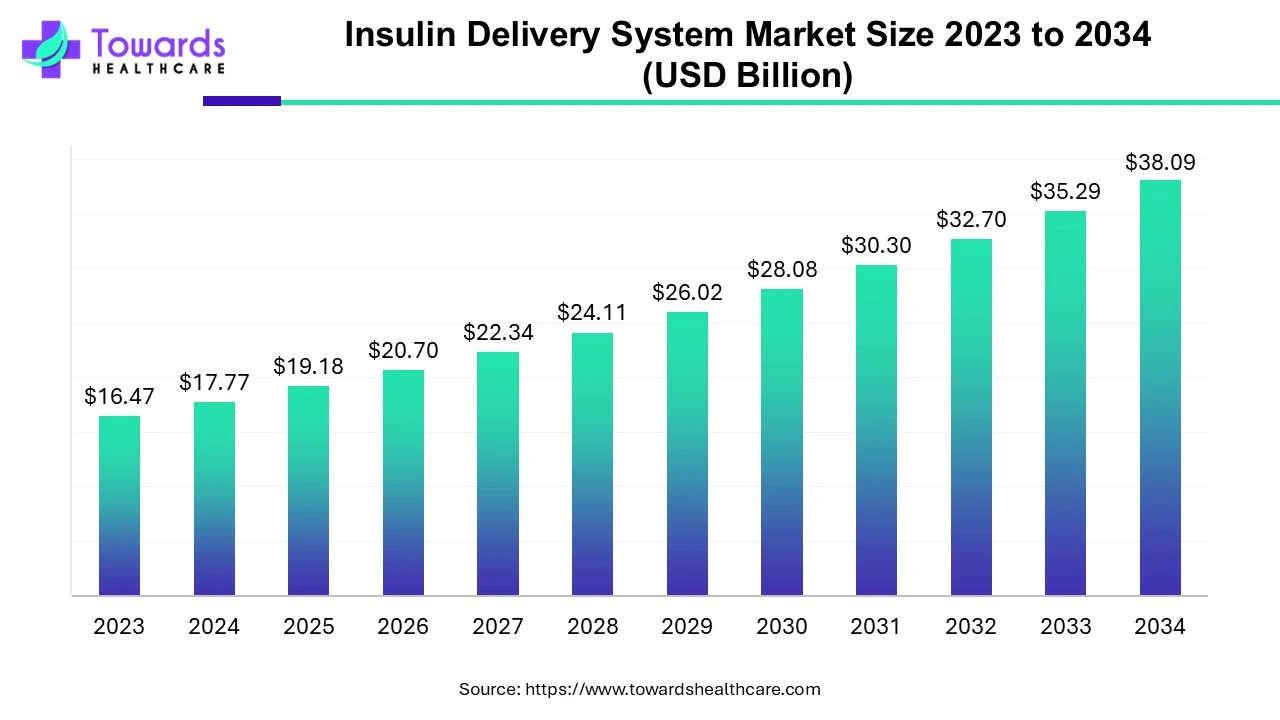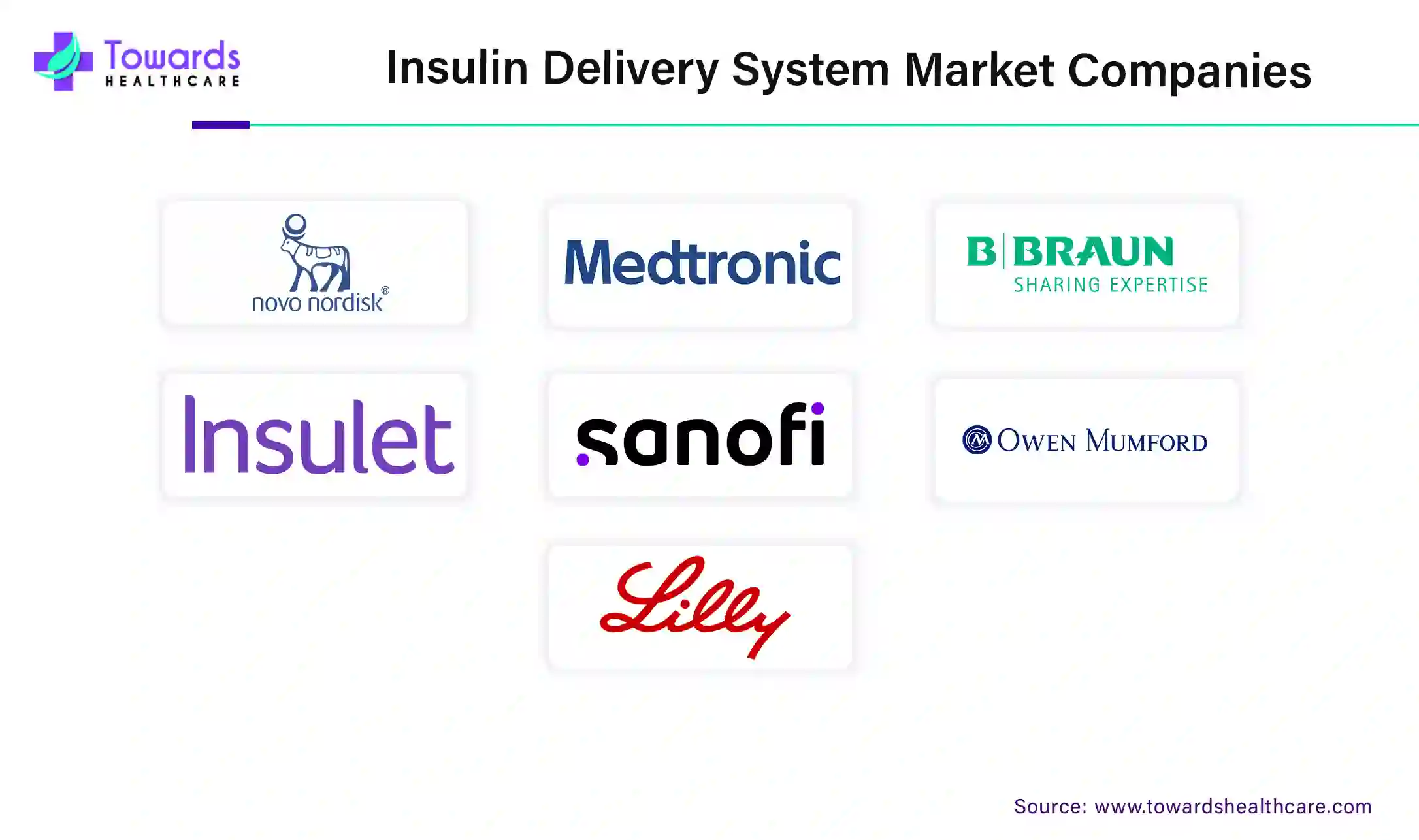April 2025

The global insulin delivery system market size is calculated at US$ 17.77 in 2024, grew to US$ 19.18 billion in 2025, and is projected to reach around US$ 38.09 billion by 2034. The market is expanding at a CAGR of 7.92% between 2024 and 2034. Technological advancements like automation, AI, and machine learning are going to support the growth of the market.

The insulin delivery system market manufactures and delivers various insulin delivery systems for the management of diabetes, a chronic condition. The purpose of these delivery systems is to ensure that people suffering from diabetes are able to administer insulin easily to maintain their blood sugar levels. The market’s demand has significantly grown in recent years due to the growing population and unhealthy lifestyle, which has led to a large population who have diabetes or are on the verge of getting it. As the cases grow, the key market players must come up with better, easy, and cost-effective solutions to fulfill the growing demand for delivery systems.
There are now new possibilities for better diabetes management thanks to advancements in healthcare technology. The first automated insulin delivery (AID) devices have received regulatory approval in recent years, and clinical treatment has begun to use these systems. Artificial intelligence may be used by future AID systems to modify their responses to the demands of the diabetic user. In the future, artificial intelligence might help with this kind of personalization and customization.
For instance,
Growing Diabetic Patients: The World Health Organization reports that there were 830 million diabetics in 2022, up from 200 million in 1990. Countries with lower and moderate incomes have seen a faster rise in prevalence than those with higher incomes. By 2050, it is predicted that the population of diabetics worldwide will have more than doubled. According to recent projections, the number of diabetics will increase from 529 million in 2021 to at least 1.3 billion in 2050. Around 9 million people worldwide have type 1 diabetes, which means they need insulin. Approximately 60 million individuals with type 2 diabetes require insulin in order to attain the best possible glycemic control.
High Cost of Insulin Systems: Insulin is more expensive and less readily available in low- and middle-income nations than in high-income ones, while cost is a problem even in wealthy nations. Insulin's high price made it frequently unaffordable. Overall, it was estimated that 37% of families with people with diabetes could not afford insulin; this number varied from 3% in high-income nations to 47% in upper-middle-income countries, 35% in lower-middle-income countries, and 63% in low-income countries.
Bionic Technology: The development of insulin delivery techniques has been characterized by notable breakthroughs in the treatment of diabetes, which will promote the insulin delivery system market’s growth in the future. Diabetes treatment is being revolutionized by bionic insulin delivery systems, which provide patients with more accurate, flexible, and user-friendly options. Patients with diabetes can now manage their condition more conveniently, effectively, and safely thanks to bionic equipment like artificial pancreas systems and sophisticated insulin pumps. By automating insulin delivery, these devices allow patients to customize their insulin profiles and do away with the need for frequent injections. The key to improving the quality of life for people with diabetes lies in ongoing research and development in the field of diabetes medical devices.
For instance,
By product, the insulin pen segment held the dominant share of the insulin delivery system market in 2023. Despite improvements in the delivery of insulin, insulin administration is still essential for the management of diabetes. The usage of insulin pens has increased, and currently, 60% of insulin users worldwide use pens. Insulin pens offer many benefits over conventional vial and syringe injections, including a higher quality of life, increased accuracy, and convenience of use for diabetics.
By product, the insulin pump segment is estimated to grow at the fastest rate in the insulin delivery system market during the forecast period. An insulin pump can provide much-needed relief for diabetics who are sick of receiving injections. Insulin pumps are compact, electronic machines. Insulin pumps have been shown to be effective for use in a variety of age groups. Modern insulin pumps are more compact, slender, and simpler to program than their predecessors because of advancements in technology. Complete closed-loop pumps, commonly known as an "artificial pancreas," will soon be a part of diabetes technology. These pumps will be able to decide basal and bolus insulin dosages on their own. Currently, prototypes are being researched.
By end-use, the homecare segment led the insulin delivery system market in 2023. Insulin doses are required on a daily basis to maintain blood glucose levels. It will become challenging for patients to visit the hospital for insulin administration on a daily basis. Therefore, the majority of devices are developed for use at home. Patients, family members, and guardians of the patients get special training to use the insulin delivery system.
By end-use, the hospitals and clinics segment is estimated to grow at the fastest CAGR in the insulin delivery system market during the forecast period. In the hospital and clinic settings, patients get professional help to monitor and regulate blood glucose. Patients often visit the hospital in order to do regular checkups and seek professional advice for better lifestyle habits and activities that need to be done.
North America dominated the insulin delivery system market in 2023. Considering the significant need for sophisticated insulin delivery systems brought on by rising levels of awareness and significant healthcare expenditures. a robust biotechnology sector and the existence of a cutting-edge healthcare business. The significant expansion of the market and the size of the jet injector device market, together with the increase in FDA approvals that support the commercialization and accessibility of different insulin delivery devices in the United States, all contribute to the growth of market demand.
In the U.S., diabetes is the sixth greatest cause of mortality, affecting over 30 million individuals. The Economic Costs of Diabetes in the U.S. External link from the American Diabetes Association estimates that the entire cost of diabetes diagnoses in 2022 will be $412.9 billion, which includes $106.3 billion in lost productivity and $306.6 billion in direct medical expenses.
Health care services are being provided to residents, and residents are being brought in for health care services by the Canadian government. By updating services for the twenty-first century, budget 2024 investments in healthcare will continue to reduce wait times and enhance access to care. Nearly $1.8 million for an extended continuous glucose monitoring program for pregnant individuals with gestational diabetes and patients with type 1 diabetes up to age 25 who are enrolled in the NL Insulin Pump Program.
Asia Pacific’s insulin delivery system market is estimated to grow at the fastest rate during the forecast period due to a rise in the prevalence of diabetes in Asia-Pacific, a sizable patient population with diabetes and pre-diabetes, a strengthening of international product manufacturers' distribution networks, and a boom in the development of cutting-edge medical facilities in developing nations like China and India.
It was predicted that between 2020 and 2030, the prevalence of diabetes in Chinese adults aged 20 to 79 would rise from 8.2% to 9.7%. The overall costs of diabetes would rise from $250.2 billion to $460.4 billion over the same time span, representing a 6.32% annual growth rate. In China, between 2020 and 2030, the overall costs of diabetes as a percentage of GDP would rise from 1.58% to 1.69%.
According to a 2023 study by the Indian Council of Medical Research-India Diabetes (ICMR INDIAB), 10.1 crore people have diabetes. Public health groups and government agencies are also contributing to better diabetes outcomes. To combat the growing threat of diabetes, the Indian government has launched a number of measures. Resources for early diagnosis, treatment, and referral to states and union territories are offered by the National Programme for Prevention and Control of Cancer, Diabetes, Cardiovascular Diseases, and Stroke (NPCDCS). This program is especially focused on evaluating people who are older than thirty. More than 10 crore qualifying families can receive free or significantly discounted medical care in government hospitals through the Ayushman Bharat-Pradhan Mantri Jan Arogya Yojana (PMJAY). A new project launched by the Ministry of Health and Family Welfare in partnership with WHO aims to increase diabetes screening and treatment to reach 7.5 crore people by 2025.

In November 2024, Doctors Without Borders (MSF) asked pharmaceutical companies Eli Lilly, Novo Nordisk, Sanofi, and all insulin manufacturers to act quickly to improve access to diabetes treatment in low- and middle-income nations by making insulin* pen injection devices available at a price of US$1 (R17.81) per pen in advance of World Diabetes Day.
By Product
By End Use
By Region
April 2025
January 2025
December 2024
November 2024